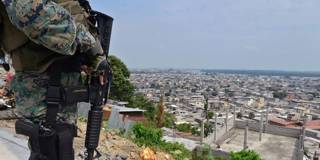Designing a progressive anti-violence strategy that delivers the safety for which a huge share of Latin Americans crave is perhaps the most difficult challenge facing many of the region’s governments. But it is also the most important.
MEXICO CITY – Violence lurks in nearly all of Latin America’s major cities. Even capitals that have traditionally been considered peaceful are coming to resemble hotspots such as Reynosa, Tijuana, Port-au-Prince, Rio de Janeiro, and Cali.
In fact, though Latin America has more than 180 million people living in poverty, and a reputation as the world’s most unequal region, violence has become the number-one concern for most countries in the region. Governments’ success or failure at reining it in has thus become a key determinant of their popular support.
El Salvador’s president, Nayib Bukele, has capitalized on popular frustration with the violence to strengthen his own position. Though Bukele’s approach to crushing gang violence has raised serious human-rights concerns – as of February 2024, his anti-violence campaign has included about 78,000 detentions and 235 deaths in state custody – his efforts have proved popular with voters. He was recently re-elected in a landslide, with 82.66% of the vote, while the left, represented by Bukele’s former party, the Farabundo Martí National Liberation Front, suffered its worst-ever result, winning a mere 6.4%.

MEXICO CITY – Violence lurks in nearly all of Latin America’s major cities. Even capitals that have traditionally been considered peaceful are coming to resemble hotspots such as Reynosa, Tijuana, Port-au-Prince, Rio de Janeiro, and Cali.
In fact, though Latin America has more than 180 million people living in poverty, and a reputation as the world’s most unequal region, violence has become the number-one concern for most countries in the region. Governments’ success or failure at reining it in has thus become a key determinant of their popular support.
El Salvador’s president, Nayib Bukele, has capitalized on popular frustration with the violence to strengthen his own position. Though Bukele’s approach to crushing gang violence has raised serious human-rights concerns – as of February 2024, his anti-violence campaign has included about 78,000 detentions and 235 deaths in state custody – his efforts have proved popular with voters. He was recently re-elected in a landslide, with 82.66% of the vote, while the left, represented by Bukele’s former party, the Farabundo Martí National Liberation Front, suffered its worst-ever result, winning a mere 6.4%.